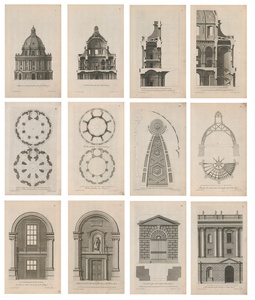| Method | Copper engraving |
| Artist | Peter Fourdrinier after James Gibbs |
| Published | [London, for the Author, MDCCXLVII (1747)] |
| Dimensions | Image size varies, each plate appoximately 354 x 200 mm, sheet 417 x 258 mm |
| Notes |
A rare set of twelve architectural plans from from James Gibbs' Bibliotheca Radcliviana: or, a Short Description of the Radcliffe Library, at Oxford, Containing Is Several Plans, Uprights, Sections, and Ornaments, On Twenty three copper Plates, neatly engraved, With the Explanation of each Plate. Plate V The Geometrical Upright of the outside of the Library. Plate VI A Part of the Outside of the Building on a larger Scale. Plate VIII One of the Iron Gates, which encloses the Stone Porch. Plate IX A Section Shewing the Inside of the Library Plate III A Geometrical Plan, of the Rustick Basement under the Library. Plate IV The Plan of the Leads abd Cupola of the Library, The Plan of the Gallery or upper Library. Plate X A Section through a part of the Library and great Stair Case. Plate XI A Section through the Circular Library's, both below and above. Plate XII The Niche over the Door in the inside of the Library with Doctors figure. Plate XIII One of the great Arches, to shew the front of the Gallery Plate XIX One Eight Part of the Ornaments in the Inside of the Dome. Plate XX A Plan of the Frame if the Cupola, with the Upright of it's Wooden Truss. Designed by James Gibbs the Radcliffe Library was constructed using funds left by the English physician, academic, and politician John Radcliffe (1650-1714). The now iconic Oxford landmark was built between 1737 and 1749 in a Baroque style. Originally intended as a separately functioning science library, it merged with the Bodleian in 1861 and is now largely a reading room. James Gibbs (1682 - 1754) was a British architect. Born in Aberdeen, Gibbs travelled extensively as a young man. In Italy he trained as an architect under Carlo Fontana. In London, he was responsible for the church of St. Mary-le-Strand, and the rebuilding of St. Martin-in-the-Fields. In Oxford, he was responsible for designing the Radcliffe Camera; the completion of the interior of Codrington Library, All Souls; and a new screen in the Hall of St John's. He was elected a member of the Society of Antiquaries in London in 1726 and fellow of the Royal Society in 1729. He published 'A Book of Architecture' (1728); 'Rules for Drawings the Several Parts of Architecture' (1732); and 'Biblioteca Radcliviana' (1747). Peter Fourdrinier (d.1750) was an eighteenth-century French engraver. Part of a refugee family who fled from Caen to Holland, Fourdrinier was a pupil of Bernard Picart in Amsterdam for six years. He moved to England in 1720 where he was employed to engrave portraits and book illustrations. He is best known for his architectural engravings, to which his mechanical style was well suited. He engraved plates for Cashel's 'Villas of the Ancients', Ware's 'Views and Elevations of Houghton House, Norfolk' (1735), Sir W. Chambers's 'Civil Architecture' (1759), Wood's 'Ruins of Palmyra' (1753) and others from the designs of Inigo Jones, W. Kent, and other architects. He also engraved the illustrations to Spenser's 'Calendarium Pastorale' (London, 1732, 8vo). Condition: Light toning to all plates, surface dirt to edges of sheet not affecting the image. |
| Framing | unmounted |
| Price | £3,000.00 |
| Stock ID | 52608 |

